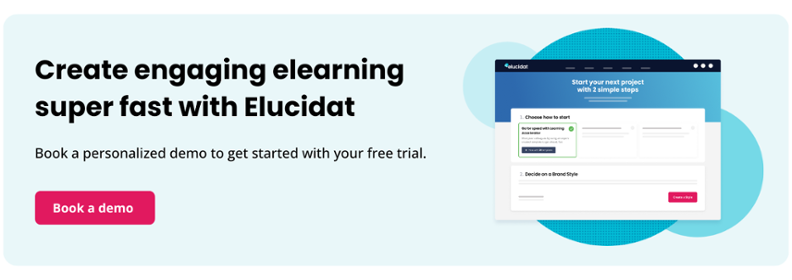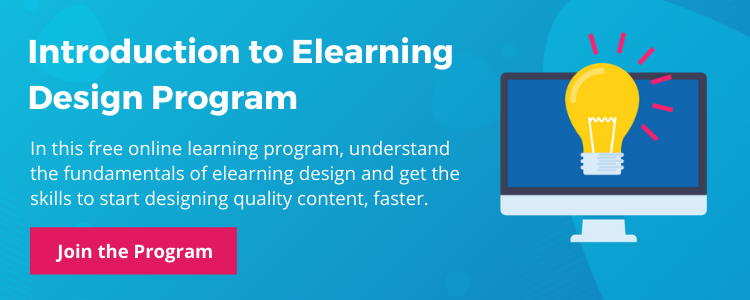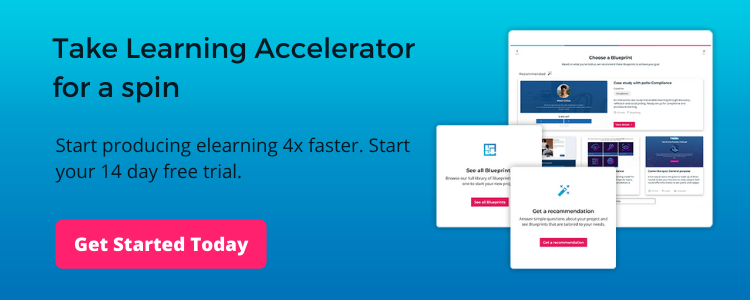Online learning vs. face-to-face training
16 minute read
Are you wondering what you can expect from making the switch from face to face to online learning courses? Elearning online training courses have never been more important and more widely used than today. All businesses are having to quickly learn how to harness the power of digital for training and development more broadly than before.
Can online learning replace face-to-face? What are the pros and cons of deploying an online training strategy? How can you make this transition a sustainable success? Read on to answer these questions and find out the next steps in your own move from face to face to online learning.

What is online learning?
Online training is the process of imparting knowledge virtually. When it comes to online training vs face to face learning, the main difference is where the training takes place. The term ‘online learning’ encompasses all learning that is conducted virtually, in an online setting. It’s basically any type of training that employees can do via a laptop, tablet or smartphone.
What is face to face learning?
Face to face learning is training that is provided in person, whether that’s a one-on-one session or in a group setting. This type of training is generally less flexible than online training, as it’s usually at a set time and place and cannot be accessed on-demand.
Your learners want digital
These days there is no question about it, your learners need digital. Organizations have to make the switch, often to survive. Online training for employees is an expectation as the workplace becomes more virtual.
Your learners have long been telling you that they are ready to make the switch from face to face to online learning. Back in 2018 Bersin by Deloitte, Fosway and many more revealed the learning habits of modern professionals. The number #1 reason workers join an organization is learning and 94% of employees say they would stay in a company if they invested in their learning and development. And, yet only 15% can access learning courses directly related to their jobs.
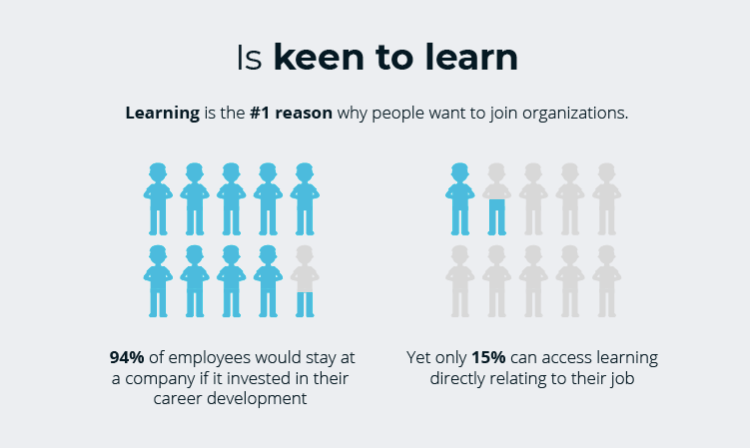
These results paint a picture of employees adapting to cope with the fast pace of modern working life. They are often busy and overwhelmed but still keen to learn; they value high quality content that’s personalized and relevant to their needs; and they are getting increasingly impatient and turned off by content and experiences that aren’t high value, relevant, and available when they want it.
Never has this been more important than now. Modern working life for many has become even more fast-paced and overwhelming. With most of the workforce working from home and companies quickly reskilling and reshuffling roles, it is imperative that your online learning stacks up to expectations and ensures productivity.
Interested to find out what the modern learner is looking for? Check out the State of Digital Learning to explore how you can get ahead of the game
The business case for transformation
Let’s move away for a moment from necessity and think long term. The case for online learning doesn’t need to be made simply as a reactive strategy. The abrupt switch from face to face to online is very challenging. But the benefits of developing a sustainable digital learning strategy is a huge business benefit in the long run.
Most employees are keen to learn and improve but struggle to find learning to help them develop their skills when they need it most. What you are doing now is futureproofing your organization. Face-to-face learning will likely see a decline for a range of reasons – environmental impact of travel and cost savings being just two.
Corporate elearning presents an opportunity to make personalized, relevant learning accessible to employees when and where they need it. And, at this time that ‘where’ is at home. Offering learners an online learning experience not only fulfils that need but also de-risks the organization.
Want to level up your elearning design skills before you get started? Get certified with this online course design to help you create engaging elearning.
The big online vs face to face learning debate (post pandemic!)
The pandemic came as a bit of a surprise to everyone! What we all thought would be the biggest training trends when it comes to face to face and online learning, changed very abruptly. Industry research and our own survey data show how there are three distinct future training trends shaping up and marking the corporate elearning debate. Here’s the wash-up of the trends and the statistics to back it up:
- The “Zoom boom” and the rise and fall of virtual instructor-led training – At the start of the pandemic we witnessed a sharp increase in the use of VILT. 67% of organizations moved their face to face training classes. A few months later though this dropped to 36%. The fact is that face-to-face training sessions don’t translate well directly into effective virtual learning experiences. And, they don’t scale well!
- The emergence of online training as a great alternative – Brandon Hall Group found that by mid-June 2020, 68% of organizations were turning to elearning online training as a sustainable alternative to face to face learning. In fact, our research shows that 82% of organizations plan to start producing more digital learning.
- The future of face to face learning is yet to be seen – The sharp rise in online learning will have a lasting effect on the L&D space. This Fosway survey found that only 5% believed that learning strategy, investment and resourcing would go back to what they were before the pandemic. And although 30% of the learning leaders we surveyed said their businesses would be returning to face-to-face training in 2022, they were also offering learners a choice of alternatives.
Looking back, it’s clear that L&D teams were essential to keeping pace with change over the last few years. LinkedIn found that nearly 75% of L&D leaders agreed that L&D became more influential – and overworked. Over 80% of the L&D leaders we surveyed highlighted that they struggled with the combination of responding at speed, maintaining quality and managing stakeholders. If businesses are going to future proof their organizations, they need an effective, sustainable and scalable L&D solution.
Online learning vs face to face learning in the workplace
The biggest differences between online and face to face learning have always been in the realm of fostering connection and collaboration between learners. The loss that Learning and Development Professionals experienced with this abrupt stop of face to face learning delivery is this positive social impact. This is a valid concern. The importance of face-to-face interaction in education, for example, is vital. In-person social interaction has a richness that might feel hard to replicate in the digital world – but, when it comes to the corporate world, it’s not impossible.
Is online learning better than face-to-face learning?
In many ways, online learning is more effective than face to face learning. As research shows 80% of organizations believe their use of digital learning will remain the same, increase or decrease only slightly as restrictions on live training ease. It is unlikely that elearning will ever fully replace classroom learning. However, what is evident is that elearning is here to stay and organizations are increasingly looking at online learning as the future with no imminent plans to invest in more face to face.
What are the advantages of distance online learning compared to face to face learning?
Here are four clear advantages of online learning:
- Elearning will save you money and time – with budgets being tight this is arguably the biggest advantage elearning has going for it. Brandon Hall found that online training requires 40 to 60 % less employee time than classroom training!
- Elearning is much more scalable – unlike face to face learning where they are always restrictions on the number of learners you can reach, elearning allows you to produce once and share with as many employees you need.
- Elearning can be accessed on your learners’ terms – research shows that the modern learner spends 33% of their time in meetings already. They want to learn as needed, any time and anywhere. Not be constrained with a date and time.
- Elearning is consistent – Classroom experiences largely depend on the instructor. The same course material can be delivered by two different facilitators with vastly different impacts on the learners. Elearning online training ensures a level of consistency that is not achievable with face to face learning.
Online learning is even more effective because many organizations are starting to incorporate the positive lessons from face-to-face into their digital strategy and creating online blended learning that tick all the boxes. A combination of self-paced learning and social group online learning, where it’s required, is the best of both worlds. The best blends tap into the opportunities offered by the different modes of learning. And, with the development of corporate elearning technologies, the old disadvantages of online training are no longer valid. Blends can be taken online and be just as effective.
Face to face learning
Online learning opens up a world of possibilities, but face to face learning may have a place in your blend.
Biggest benefits: The key advantages of face to face training come from being synchronous. Synchronous learning occurs when a group is engaged in learning at the same time and location.
Face to face interaction with an instructor and other participants enables more effective non-verbal communication. Positive body language in a classroom setting has the ability to motivate, inspire and engage. Whether it’s eye contact or posture, being able to read people’s body language and adapt the content and approach leads to better learning results.
Face to face training methods offer the ability to discuss, collaborate, practice and role play, all ‘live’ and with guidance from a facilitator on hand. Being part of a group and being held accountable are powerful learning tools.
Opportunities: This social element of face to face learning can certainly be taken online. Technology, such as video conferencing and virtual classrooms, enables the workforce of today to still collaborate just as effectively. Plus taking learning online also means that people are not held from learning what they need, when they need it. With minor tweaks, such as smaller training groups, face to face trainers can still have the same impact online and the same level of social benefits.
Blended online learning
Biggest benefits: Let’s face it, these days there is no other choice but to go online. But sometimes the best things come out of necessity. Online blended learning done right today will de-risk your organization for the future, make you more sustainable and save you time and money. Other benefits of strategies of blended learning include making your online learning:
- Flexible: A digital-first blend lets people take online learning wherever and whenever they want – perfect for hybrid working.
- Streamlined: A series of shorter learning experiences help you to reskill or upskill employees faster.
- Personalized: Blended learning offers the chance to create a range of routes through your online learning, leading to more tailored, relevant experiences.
- Social: Blends can have social learning woven throughout to keep connections going between colleagues.
Opportunities: The opportunities blended digital learning presents are wasted if your learning is a ‘one size fits all’ experience that doesn’t recognize the individual. It’s time we adopt a more modern blend – which is where flexible blended learning comes in.
A flexible blend focuses on what your business and employees really need now, rather than trying to maintain the approaches of the past. These blends are:
- Digital-first: Explore the formats available to you – such as VILT, elearning, video-based learning, etc – and identify which will be most effective for your needs, now and in the future.
- Concise: Make use of role selectors, diagnostics and microlearning designs to keep learning short and relevant.
- Paced: Maximize the impact of each intervention by pacing your supporting content. For example, offer the theory as elearning ahead of a VILT, so that session can focus solely on application.
- Social: Create digital spaces for sharing ideas and promoting reflection.
Best practice blended learning
Take a look at the three examples below to see how some common online training topics can be turned into digital blended learning programs. The examples show how blended learning online can incorporate face to face elements and seamlessly translate these into a digital space. They’re all designed to make a real-life impact and help learners achieve tangible goals. At Elucidat, we call this people-centered elearning.
Soft skills training
Let’s not forget that in these challenging times, many of our employees are feeling even more strain than usual. Making sure their soft skills training needs are met should not be put on hold. In fact, topics like delegation and time management are if anything even more important. People working from home often need more, not less, management if productivity and positivity are to stay high.

1. Reflective digital activity
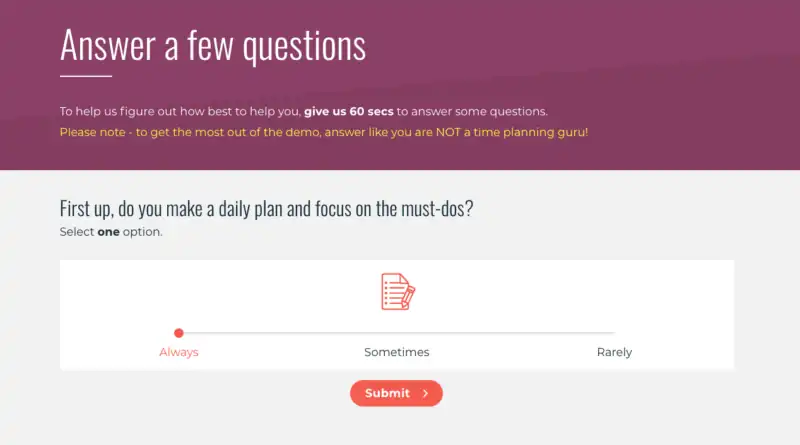
Some of your employees are currently working while at the same time looking after their children, others might be easily distracted with household chores. Learning how to manage one’s time is paramount! Online training offers a better blend which begins with a warm-up activity that asks learners to reflect on how they currently manage their time. Personal questions are engaging and hold people’s attention, and the smart back-end of this Elucidat project tailors the tips and feedback provided based on answers each learner gives. Have a go yourself to see how personalized digital learning can be!
2. Expert videos
Personal reflection could be followed up with expert videos that provide time management tips and techniques. Having reflected on their current skills, learners are more likely to be open to learning from the experts, and videos mean they can find a time to learn that suits them, whether that’s between childcare shifts or in between meetings. Do you perhaps have employees or contractors that have been working from home even before this crisis? If so they might just be the subject matter experts (SMEs) you need to share their experiences.
3. Face to face role play with manager or mentor
A lot of soft skills success is in the execution, so the human element of a role play is useful here. This doesn’t mean this can’t be done online! It’s an opportunity for learners to put their reflection and theory into practice, getting feedback from a manager or mentor before applying ‘in real life’. Using a video conferencing platform, such as Zoom, is just as effective in providing that one-on-one care and support.
Product knowledge training
With so many people switching their job roles and recruitment in some sectors being done in a matter of hours just to fill in for people off sick, getting staff quickly up to speed with products is a must.
Product knowledge is all about making facts easy to remember and easy to link with customer needs. There’s often a lot of detail for individuals to retain, so information should be easy to look up in the moment as well as revise ahead of time.

1. Digital product info-sheets
There’s no escaping the need to communicate a lot of facts and detail. Breaking this down into a modern, digital product sheet makes it more appealing to learners, easier to update and provides an opportunity for interactivity. Take a look at this example of a fresh, scrollable, digital one-pager.
2. 2-minute tutorials
When a customer asks a question that a newly appointed customer service rep can’t remember the answer to, a super-short, mobile-friendly refresher is more likely to do the trick.
3. Elearning scenarios
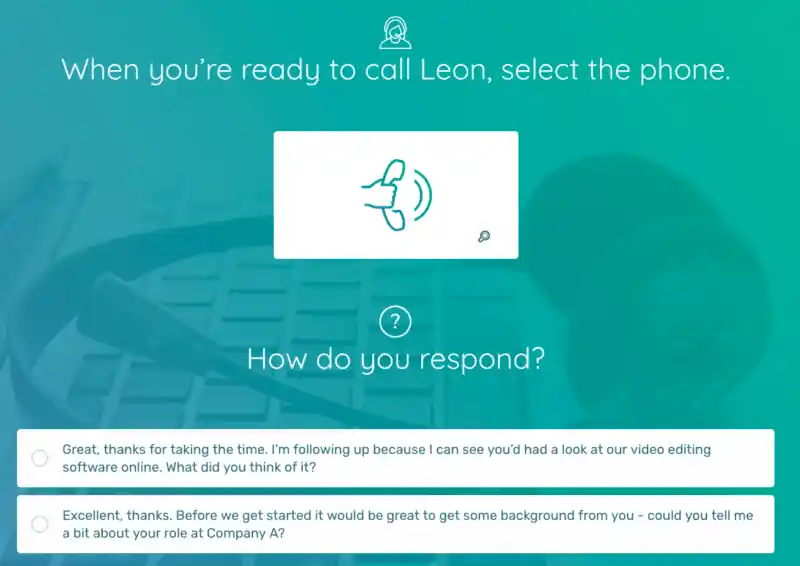
Recalling facts isn’t enough; customer service advisors also need to be able to effectively recommend products to appropriate customers. Particularly these days when new sales in some sectors are drying out – upsell and cross-sell become even more important for survival. An elearning scenario is perfect for making sure your team is ready for the challenge, allowing the learner to practice in a safe environment and receive feedback. Since video conferencing is a hot topic these days and many providers are bringing in new staff to cater for the demand, we thought a sales simulation for a video platform would fit well here. This example shows how learners can practice a realistic sales conversation in a digital format.
4. Digital pop-quiz
A competitive pop quiz every three months could help keep the learning alive. Add some offline rewards as motivation such as entry into a prize draw for some online vouchers – and suddenly your team are voluntarily revising this product knowledge every quarter!
Onboarding training
Onboarding employees is a hot topic these days with many organizations. Particularly for those working in food retail, where they might be frantically employing new staff to respond to higher demands and to cover sickness. With a modern, personalized digital blend, your onboarding training could go from reactive to a sustainable and valuable training experience that learners rate highly.
1. Pre-boarding and knowledge-based online learning
Start your onboarding training by welcoming your new employees into your organization.
This can be done while contracts and paperwork are being finalized. Introduce your new starters to fundamentals and common questions. For example, the organization’s values, how the stores are structured, expectations for their role, etc.
Once you have introduced the new starter to the basics, it’s time to go a bit deeper. Take the simplest element of the job and introduce the new starter to the key steps that they need to know to complete it. For example, a quick overview of the process, a best-practice example and a list of dos and don’ts. It might only take 10 minutes.
2. On the job training
This is the point where you bring in some on the job learning. The role of the supervisor or the learner’s peers is essential here. The new starter buddies up with a supervisor or experienced colleague to shadow them and see their new knowledge in practice. They then practice themselves, with their buddy there to give feedback and answer questions. This might take half an hour. The new starter can then confidently move forward working on that task independently.
3. Repeat for all core skills
Finally, later or the next day, the new starter takes the next piece of knowledge-based elearning for a different area such as customer service. They then buddy up with their colleague again. This cycle continues until all core job skills have been learned and applied.
This is a great example of a one-page digital onboarding experience that aims to get new or redistributed staff up to speed – fast!

The example has been built with Elucidat’s Learning Accelerator. This handy feature includes useful templates that make it easy for anyone to create awesome training, super-fast. The templates are recommended based on your project goals. In this example, we feature how this might work for onboarding but the possibilities are endless. The best practice is baked into the templates so your team can focus on content and the tool does the heavy lifting.
How to implement blended learning in the workplace
If the online blended learning programs above have got you excited, you’re probably starting to think about the practicalities – how can you design similar programs for your specific needs? There are three key steps to creating a successful digital blended program: understand your audience, analyze content and match it to your delivery channel.
Understand your audience and your goals
The first step in digital training design is no different to face to face training design – get to know your audience and the type of learning that will work for them. Before you kick things off make sure that you also understand your goals!
With a fresh understanding under your belt, you’re ready to focus on your content.
Analyze your content
All the time invested in your current face-to-face training is not wasted. This is where it comes into play. Do a spring clean and break down the content into smaller chunks, noting down the learning objective for each chunk.
Match your content with a delivery channel
This is where things get really interesting these days. You know what works offline but how can you create similar experiences with the digital channels available to you? Start by reviewing the channels you have at your disposal. Face to face might be off the table but there are many other ways to bring your content to life online.
Blended online learning can come to life in many different ways, such as interactive elearning scenarios, microlearning modules, VILT sessions, online coaching and mentoring, pre-recorded videos, and informal social learning. Take a look at some more examples here.
Get the skills you need in your team
With a clear vision of what you need to produce, it’s time to assess whether you have the skills in house to create the components. If you’ve been creating and delivering face to face training, then the chances are that you already have Learning Design skills and Subject Matter Expertise. It’s the digital element that you might still be looking for.
At Elucidat we can provide learning resources and professional services to help upskill and empower teams to create great digital learning. Find out more about how our Learning Consultancy services can help you in this quick diagnostic (built in Elucidat!).
Final thoughts
In these unprecedented times face to face learning is no longer viable. Now that you are done with firefighting in the initial aftermath of the outbreak, it is time to future proof your organization. A successful flexible digital learning blend is the solution. By harnessing the skills you already have, upskilling your face-to-face team and taking inspiration from digital learning examples, you will be able to tackle the move head-on.
Remember that the most successful blends have a clear purpose and audience, utilize a range of digital channels and are created by a skilled in-house team, using elearning authoring tools.
Like the examples you’ve seen using Elucidat? Book a demo today to see how we can support your digital transformation. And, if you are still not sure which tool is right for your team, check out our comparison blog on the best elearning authoring software .
Also, here’s a pick of our top guides, programs and articles in case you want to more tips on making the switch:
- Get certified in engaging elearning design with this online course
- The ultimate guide to designing best practice elearning
- How to boost elearning engagement with compelling content
- How to make enterprise elearning a success
- 4 steps to create an elearning course with impact
